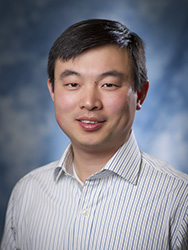PhD
Associate Professor, Biochemistry and Biophysics
Member, UNC RNA Research Group
UNC-Chapel Hill
Cancer Cell Biology
Area of Interest
Our laboratory is primarily focusing on developing and applying solution-state NMR methods, together with computational and biochemical approaches, to understand the molecular basis of RNA function. In particular, we aim to visualize, with atomic resolution, the entire dynamic process of ribozyme catalysis, riboswitch-based gene regulation, and co-transcriptional folding of mRNA. The principles deduced from these studies will provide atomic basis for rationally manipulating RNA catalysis and folding, and for de novo design of small molecules that target specific RNA signals involving in cancer and human disease. Research program in the laboratory provides diverse training opportunities in areas of spectroscopy, biophysics, structural biology, computational modeling, and biochemistry.
Awards and Honors
- NSF Career Award, 2017
- UNC Jefferson Pilot Fellowship, 2015
- The March of Dimes Basil O’Connor Starter Scholar Research Award, 2013
- The Baltimore Family Fellow of the Life Sciences Research Foundation, 2008
- The RNA Society/Scaringe Young Scientist Award, 2008
News and Stories

UNC RNA Discovery Center awards inaugural fellowship grants
The UNC RNA Discovery Center has awarded three fellowship grants to support innovative research investigating various roles of RNA in health and disease.

NCI awards Pecot $1.8 million lung cancer research grant
The grant will support Chad Pecot, MD, and his research investigating the roles circular RNA may have in regulating whether a form of lung cancer will spread beyond the original cancer site.

UNC Lineberger creates RNA Discovery Center
The UNC RNA Discovery Center, led by Chad Pecot, MD, will cultivate an inclusive community of scientists dedicated to investigating all aspects of RNA biology.

Researchers reveal safeguarding of a key DNA sensor in the innate immune system
Qi Zhang, PhD, Robert McGinty, MD, PhD, and team determined the high-resolution structure of a key DNA-sensing protein in the innate immune system called cGAS while it is bound to the nucleosome.

